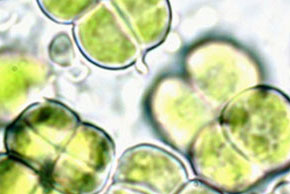

UFSCar researchers cultivate microalgae in a laboratory to sequester carbon from the atmosphere and develop biomolecules for application in energy and agriculture
Researchers cultivate microalgae in a laboratory to sequester carbon from the atmosphere and develop biomolecules for application in energy and agriculture
Researchers cultivate microalgae in a laboratory to sequester carbon from the atmosphere and develop biomolecules for application in energy and agriculture

UFSCar researchers cultivate microalgae in a laboratory to sequester carbon from the atmosphere and develop biomolecules for application in energy and agriculture
By Elton Alisson
Agência FAPESP – Microalgae have multiple uses such as being the source of biomolecules for development of new products with applications in the foodstuff, cosmetics, pharmaceutical and petrochemical industries, in addition to being utilized for sequestering carbon in the atmosphere.
Nevertheless, precisely because of the increased carbon dioxide levels in the atmosphere caused by global warming, these microorganisms have diminished in oceans in the last 100 years. A loss that contributed even further to the increase in CO2 in the atmosphere and to the decrease of oceanic and fishing resources, say international studies.
In order to utilize these marine microorganisms both for large-scale biological carbon dioxide sequestering, as well as for producing biomolecules for diverse ends, such as energy and agriculture, researchers at the Universidade Federal de São Carlos (UFSCar), in partnership with Braskem, are cultivating microalgae cells in a laboratory.
FAPESP and Braskem co-funded the project through the former’s Partnership for Technological Innovation Research (PITE) program. Initiated in 1995, PITE has funded research projects developed in cooperation between company research centers, academic institutions and research institutes through joint-financing programs with the Foundation and companies.
The results obtained by some of the projects were presented during the FAPESP-ABC workshop on Collaborative University-Company Research. Sponsored by FAPESP and the Brazilian Academy of Sciences (ABC) and held on November 7 and 8, the event ran concurrently with Inovatec (Business Fair for Technological Innovation among Companies, Research Centers and Universities), organized by the São Paulo State Confederation of Industry and São Paulo State Secretariat of Economic Development, Science and Technology.
Through the project, initiated a year ago, UFSCar researchers developed a closed-continuous photobioreactor with the 200-liter capacity for cultivating microalgae cells of the Chlorella vulgaris genus in greenhouses.
In the next stage, in 2012, the researchers intend to increase the equipment’s capacity to 1,000 liters of water. And at the end of the project in 2013, the aim is to reach a controlled production capacity of microalgae culture in 3,500 liters of water in natural environments.
“The 200-liter capacity photobioreactor is a hybrid of the microalgae production system in open tanks and a closed bioreactor, bringing together the good characteristics of both,” explained Ana Teresa Lombardi, professor at UFSCar and coordinator of the project, at the workshop during the event.
Although it offers lower cost and greater maintenance ease compared to closed photobioreactors, open tanks have a high contamination risk and prevent biochemical manipulation of the composition of microalgae – the factor that allows for creation of biomolecules for production of diverse compounds.
Through diverse experiments for physiological control of microalgae and thermal analysis techniques, which should be conducted in an algae biotech laboratory to be built at UFSCar, the researchers intend to develop energetic biomolecules for biofuel production.
The final residue of this entire cultivation process in the photobioreactor will also be tested, as a means of cultivating vegetables and recovering native vegetation and degraded cerrado soils.
“The project has been going very well. The first objective, which was to increase productivity of microalgae and control the biochemical composition of them, has practically been reached,” said Lombardi.
The next objective to be reached by researchers will be to improve continuous cultivation technology, increasing control of the physiological state of microalgae.
Republish
The Agency FAPESP licenses news via Creative Commons (CC-BY-NC-ND) so that they can be republished free of charge and in a simple way by other digital or printed vehicles. Agência FAPESP must be credited as the source of the content being republished and the name of the reporter (if any) must be attributed. Using the HMTL button below allows compliance with these rules, detailed in Digital Republishing Policy FAPESP.





